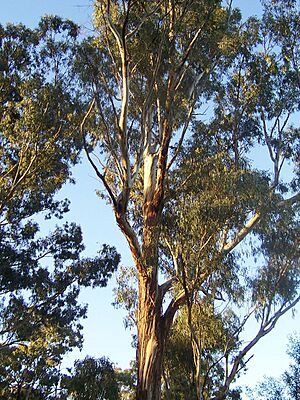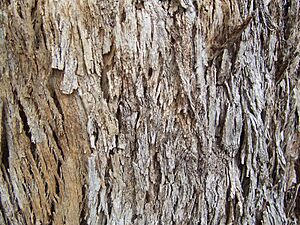Eucalyptus facts for kids
Quick facts for kids Eucalyptus |
|
|---|---|
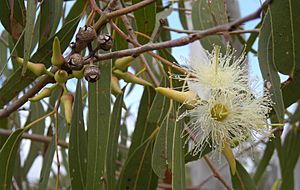 |
|
| Buds, capsules, flowers and foliage of E. tereticornis | |
| Scientific classification |
|
| Kingdom: | Plantae |
| Clade: | Tracheophytes |
| Clade: | Angiosperms |
| Clade: | Eudicots |
| Clade: | Rosids |
| Order: | Myrtales |
| Family: | Myrtaceae |
| Subfamily: | Myrtoideae |
| Tribe: | Eucalypteae |
| Genus: | Eucalyptus L'Hér. |
| Type species | |
| Eucalyptus obliqua L'Hér. 1789
|
|
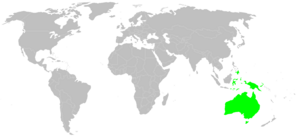 |
|
| Natural range | |
| Synonyms | |
|
|
Eucalyptus is a group of trees. People also call them eucalypts. This name includes seven similar plants from the Eucalypteae family. All these plants come from Australasia. They are Eucalyptus, Corymbia, Angophora, Stockwellia, Allosyncarpia, Eucalyptopsis, and Arillastrum.
There are over 700 types, or species, of eucalypts. Almost all of them grow naturally in Australia. You can find eucalypts in nearly every part of Australia. They have adapted to many different habitats. This shows they likely evolved after Australia broke away from the supercontinent Gondwana. Besides Australia, you can only find eucalypts naturally in New Guinea, the Philippines, and a few small islands.
Many eucalypts are called gum trees. This is because they release a lot of sticky sap if their bark gets broken. Eucalyptus trees have many other local names too. Some are 'mallee', 'box', 'ironbark', 'stringybark', and 'ash'.
Contents
What do Eucalyptus Trees Look Like?
Flowers and Leaves
Eucalypts have very special flowers and fruits. No other trees have them. When a eucalyptus flower grows, a bud cap forms around it. This cap is made of petals. It stays on until the flower is ready to open. Then the bud cap falls off. This reveals a flower that has no petals at all!
The woody fruits are called gumnuts. They are usually shaped like a cone. They open at one end to let out their seeds.
Most eucalypts are evergreen. This means they keep their leaves all year. But some types in tropical areas lose their leaves in the dry season. Eucalyptus leaves have tiny oil glands. The oils from these leaves are often used to help with coughs and colds.
Many eucalypts change their leaf shape as they get older. Young eucalyptus trees have round leaves. After one or two years, the leaves of most types become longer. They look like spearheads or sickles. A few types keep their round leaves their whole lives. Most eucalypts do not flower until their adult leaves start to appear.
Bark Types
The bark of a eucalyptus tree dies every year. On smooth-barked trees, most of the old bark falls off. This leaves a smooth, often colorful surface. For rough-barked trees, the dead bark stays on the tree. It dries out and becomes rough. Many eucalypts have smooth bark at the top. But they have rough bark lower down.
These different bark types help scientists group eucalypts. This is helpful because there are hundreds of kinds! Grouping them makes them easier to understand.
Here are some different bark types:
- Stringybark – This bark has long strands. You can pull them off in long pieces. It is usually thick and feels spongy.
- Ironbark – This bark is hard, rough, and has deep grooves. It is soaked with dried sap. This gives it a dark red or even black color.
- Tessellated – This bark is broken into many clear flakes. These flakes are like cork and can peel off.
- Box – This bark has short fibers.
- Ribbon – This bark comes off in long, thin pieces. But it stays loosely attached in some spots. The pieces can be long ribbons, firm strips, or twisted curls.
How Tall Can They Grow?
Today, some Australian Mountain Ash trees are among the tallest trees in the world. They can grow up to 92 meters (about 300 feet) tall! They are the tallest of all flowering plants. Taller trees, like the coast redwood, are conifers (cone-bearing trees). There is proof that when Europeans first came to Australia, some Mountain Ash trees were the tallest plants on Earth.
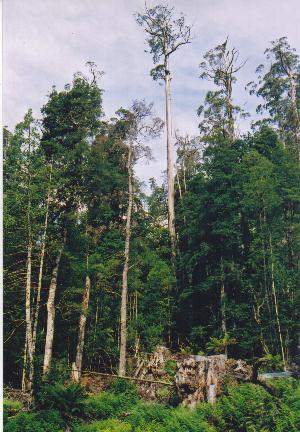
Surviving the Cold
Most eucalypts cannot survive frost. Or they can only handle light frosts down to about -3°C to -5°C. The toughest eucalypts are called "snow gums." One type, Eucalyptus pauciflora, can handle cold and frost down to about -20°C. Two wild types of this tree can even survive colder winters.
Several other kinds, especially from the high plateaus and mountains of central Tasmania, have also developed very cold-hardy forms. Seeds from these tough trees are planted in colder parts of the world as ornamental trees.
Animals and Eucalyptus Trees
Eucalyptus leaves contain an oil. This oil is a strong, natural cleaner. It is used in some medicines. But it can be harmful if you take too much. Some marsupials, like koalas and certain possums, are partly resistant to this oil. These animals can tell which plants are safe to eat by their smell.
Eucalypts also make a lot of nectar. This sweet liquid is food for many insects.
Dangers from Eucalyptus Trees
Eucalypts have a habit of dropping whole branches as they grow. Eucalyptus forests are often covered with dead branches. The Australian Ghost Gum (Eucalyptus papuana) is sometimes called the "widow maker." This is because many tree-cutting workers were killed by falling branches. Many deaths also happened when people simply camped under them. The trees shed whole, very large branches to save water during droughts. Because of this, you should never camp under large eucalyptus branches.
Eucalyptus and Fire
On warm days, eucalyptus oil vapor rises above the bush. This creates the famous blue haze seen in the Australian landscape. Eucalyptus oil catches fire very easily. Bushfires can spread quickly through the oil-rich air in the tree tops. The dead bark and fallen branches also burn easily.
Eucalyptus trees are very good at surviving fires. In fact, most types need fires to spread and grow again. They do this in several ways:
- They can sprout new growth from underground tubers.
- They have hidden buds under their bark that can grow after a fire.
- Their seeds can sprout in the ashes after a fire has opened them.
How Fire Helped Eucalypts Spread
Eucalypts first appeared between 35 and 50 million years ago. This was not long after Australia and New Guinea separated from Gondwana. Their appearance matches a time when more fossil charcoal was found. This might mean fire was important to them even then.
They were a small part of the rainforest until about 20 million years ago. Then, Australia slowly became drier. The soil also became less rich. This led to more open forests, mainly with Casuarina and Acacia trees. When the first humans arrived about 50,000 years ago, fires became much more common. The fire-loving eucalypts soon grew to make up about 70% of Australian forests.
Eucalypts grow back quickly after a fire. However, two valuable timber trees, Alpine Ash and Mountain Ash, are killed by fire. They can only grow back from seeds. A fire that had little effect on forests around Canberra could kill thousands of acres of these trees elsewhere.
How People Use Eucalyptus Trees
Eucalyptus trees have many uses. This makes them very important. They grow fast, so their wood is a main benefit. People use them for planting in parks and gardens. They also provide timber, firewood, and pulpwood for paper. Their fast growth also makes eucalypts good for windbreaks.
Eucalypts drink a lot of water from the soil. They have been planted in some places to lower the water table. This helps reduce the amount of salt in the soil. Eucalyptus trees have also been used to help reduce malaria. They do this by drying out wet soil in places like Algeria, Sicily, mainland Europe, and California. Drying the soil removes swamps where mosquito larvae live. But this can also accidentally destroy other harmless habitats.
Eucalyptus oil is made from the leaves by steaming them. It can be used for cleaning and making things smell good. In very small amounts, it is used in food supplements. These include sweets, cough drops, and medicines for stuffy noses. Eucalyptus oil can also keep insects away.
The nectar from some eucalypts makes high-quality honey. In the western United States, they flower in late January. This is before other nut and fruit trees flower. This means their nectar can easily be made into its own kind of honey. This honey is said to have a buttery taste.
The leaves of the ghost gum were used by Aborigines to catch fish. Soaking the leaves in water releases a mild tranquilizer. This stuns fish, making them easy to catch.
Eucalyptus wood is also used to make the digeridoo. This is a musical wind instrument made famous by the Aborigines.
Problems Caused by Eucalyptus Trees
Eucalypts were first brought to other parts of the world by Sir Joseph Banks. He was a botanist on the Cook expedition in 1770. Since then, they have been planted in many countries. Several types have become invasive. This means they spread out of the area where they were planted. They can cause problems for local wildlife.
Spain
In Spain, eucalypts have been planted in timber plantations. They replaced native oak woodlands. In these areas, the original woodlands supported many native animals. But the eucalyptus groves cannot support the local wildlife. This leads to quiet forests and fewer animal populations. However, eucalypts do help several industries. These include sawmilling, making pulp, and producing charcoal.
California
In the 1850s, many Australians went to California for the California Gold Rush. Much of California has a climate similar to parts of Australia. So, some people thought it would be a good idea to bring eucalypts there. By the early 1900s, thousands of acres of eucalypts were planted. The state government even encouraged it. People hoped they would provide a new source of wood for building and furniture.
However, this did not happen. One reason was that the trees were cut when they were too young. Another reason was that Americans did not know how to treat the cut wood. This caused the wood to twist and split.
One way eucalyptus trees, mainly the blue gum, were useful in California was as windbreaks. They protected highways, orange groves, and other farms. This was especially helpful in the mostly treeless central part of the state. They are also admired as shade and ornamental trees in many cities and gardens.
Eucalyptus forests in California have been criticized. They push out native plants and do not support native animals. Fire is also a big problem. The 1991 Oakland Hills firestorm destroyed almost 3,000 homes. It also killed 25 people. This fire was partly fueled by many eucalyptus trees near the houses.
In some parts of California, eucalyptus forests are being removed. Native trees and plants are being brought back. Some people have also illegally destroyed some trees. They are suspected of bringing in insect pests from Australia that attack the trees.
Brazil
In 1910, eucalypts were brought to Brazil. They were meant to provide wood and charcoal. Sadly, the long-term effects were not studied. Now, eucalypts are causing problems because they use a lot of water. This makes the soil dry out. This can kill many local plants that local animals need to survive.
Images for kids
-
Eucalyptus forest in East Gippsland, Victoria. Mostly Eucalyptus albens (white box).
See also
 In Spanish: Eucaliptos para niños
In Spanish: Eucaliptos para niños


